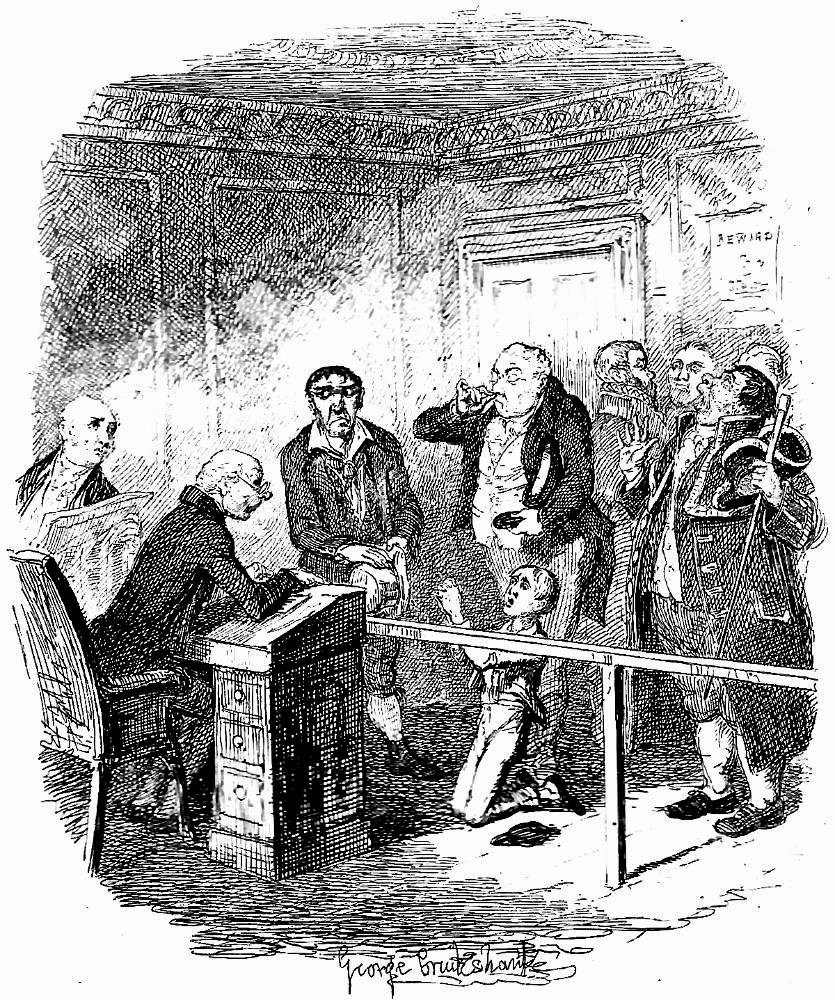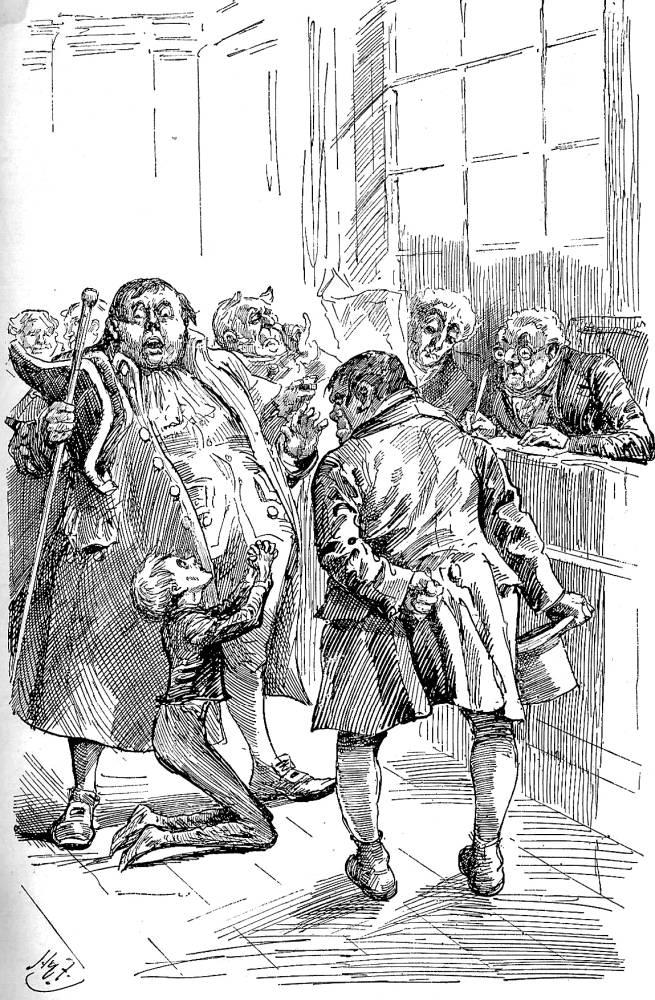

Oliver Twist escapes being bound apprentice to the sweep — the second steel engraving and later watercolour for Charles Dickens's The Adventures of Oliver Twist; or, The Parish Boy's Progress, first published in volume by Richard Bentley after its March 1837 appearance in Bentley's Miscellany, Chapter II. 4 ½ by 3 ¾ inches (11.5 cm by 9.8 cm), vignetted, facing page 16 in the 1846 edition (originally leading off the monthly instalment). Cruikshank's own 1866 watercolour, commissioned by F. W. Cosens, is the basis for the 1903 chromolithograph. [Click on the images to enlarge them.]
Passage Illustrated: Oliver avoids a highly dangerous occupation
"I have no doubt you are, my friend," replied the old gentleman: fixing his spectacles more firmly on his nose, and looking about him for the inkstand.
It was the critical moment of Oliver's fate. If the inkstand had been where the old gentleman thought it was, he would have dipped his pen into it, and signed the indentures, and Oliver would have been straightway hurried off. But, as it chanced to be immediately under his nose, it followed, as a matter of course, that he looked all over his desk for it, without finding it; and happening in the course of his search to look straight before him, his gaze encountered the pale and terrified face of Oliver Twist: who, despite all the admonitory looks and pinches of Bumble, was regarding the repulsive countenance of his future master, with a mingled expression of horror and fear, too palpable to be mistaken, even by a half-blind magistrate.
"The old gentleman stopped, laid down his pen, and looked from Oliver to Mr. Limbkins; who attempted to take snuff with a cheerful and unconcerned aspect.
"My boy!" said the old gentleman, "you look pale and alarmed. What is the matter?"
"Stand a little away from him, Beadle," said the other magistrate: laying aside the paper, and leaning forward with an expression of interest. "Now, boy, tell us what's the matter: don't be afraid."
Oliver fell on his knees, and clasping his hands together, prayed that they would order him back to the dark room — that they would starve him — beat him — kill him if they pleased — rather than send him away with that dreadful man.
"Well!" said Mr. Bumble, raising his hands and eyes with most impressive solemnity. "Well! of all the artful and designing orphans that ever I see, Oliver, you are one of the most bare-facedest."
"Hold your tongue, Beadle," said the second old gentleman, when Mr. Bumble had given vent to this compound adjective. [Chapter III, "Relates How Oliver Twist was Very Near Getting a Place, Which Would Not Have Been a Sinecure," pp. 15-16 in the 1846 edition]
Commentary: The First of the Novel's Courtroom Scenes
Oliver's experience in asking for more, despite the beating he took for his temerity, leads him to defend himself when he perceives himself to be ill-used or ill-served by callous authority. As a chimney sweep, he probably would not have survived childhood owing to the health and safety hazards associated with how boys were deployed in the trade.
Again, Oliver astonishes an authority figure — this time, the parish Beadle, Mr. Bumble — by daring to assert himself. The adults who will determine his future dwarf Oliver here: officious Mr. Bumble in uniform; the master of the workhouse, Mr. Limbkins (centre, in front of the magistrate's desk), taking snuff and disregarding the potential apprentice entirely; the sooty, Neanderthal-like chimney-sweep Mr. Gamfield, whose villainous countenance is in complete contradiction of the magistrate's describing him as "an honest, open-hearted man" (15); and the wigged, elderly gentleman, the presiding magistrate, left. Two elements prepare us for future scenes: the benevolent magistrate anticipates the kindly Mr. Brownlow (also associated with writing and reading), and the reward poster (above Bumble's head) foreshadows Oliver's running away from his apprenticeship at the undertaker's, Mr. Sowerberry, in Part 4 (May 1837).
Illustrations from the Household (1871) and the Charles Dickens Library Editions (1910)


Left: Harry Furniss's Charles Dickens Library Edition illustration of the same scene emphasizes the size of the adults, whom Furniss makes into giants who dwarf the pleading Oliver: Oliver refuses to be Bound over to the Sweep (1910). Right: James Mahoney's Household Edition street scene realizes Bumble's next attempt at obtaining an unpleasant apprenticeship for Oliver: "Liberal terms, Mr. Sowerberry, liberal terms!" (1871). [Click on the images to enlarge them.]
Related Material
- Depictions of Bumble, the Parish Beadle from Oliver Twist and other Beadles
- Oliver Twist as a Triple-Decker
- Oliver untainted by evil
- Like Martin Chuzzlewit, it agitates for social reform
- Oliver Twist Illustrated, 1837-1910
Scanned images and text by Philip V. Allingham. [You may use these images without prior permission for any scholarly or educational purpose as long as you (1) credit the photographer and (2) link your document to this URL in a web document or cite the Victorian Web in a print one.]
Bibliography
Bentley, Nicolas, Michael Slater, and Nina Burgis. The Dickens Index. New York and Oxford: Oxford U. P., 1990.
Cohen, Jane Rabb. "George Cruikshank." Charles Dickens and His Original Illustrators. Columbus: Ohio State U. P., 1980. Pp. 15-38.
Darley, Felix Octavius Carr. Character Sketches from Dickens. Philadelphia: Porter and Coates, 1888.
Davis, Paul. Charles Dickens A to Z: The Essential Reference to His Life and Work. New York: Facts On File, 1998.
Dickens, Charles. Oliver Twist. Illustrated by George Cruikshank. London: Bradbury and Evans; Chapman and Hall, 1846.
_______. Oliver Twist. Works of Charles Dickens. Household Edition. 55 vols. Illustrated by F. O. C. Darley and John Gilbert. New York: Sheldon and Co., 1865.
_______. Oliver Twist. Works of Charles Dickens. Diamond Edition. 18 vols. Illustrated by Sol Eytinge, Jr. Boston: Ticknor and Fields, 1867. Vol. II.
_______. Oliver Twist. Works of Charles Dickens. Household Edition. 22 vols. Illustrated by James Mahoney. London: Chapman and Hall, 1871. Vol. II.
_______. Oliver Twist. Works of Charles Dickens. Charles Dickens Library Edition. 18 vols. Illustrated by Harry Furniss. London: Educational Book Company, 1910. Vol. III.
Forster, John. "Oliver Twist 1838." The Life of Charles Dickens. Ed. B. W. Matz. The Memorial Edition. 2 vols. Philadelphia: J. B. Lippincott, 1911. Vol. 1, book 2, chapter 3. Pp. 91-99.
Grego, Joseph (intro) and George Cruikshank. "Oliver Twist escapes being bound apprentice to the sweep." Cruikshank's Water Colours with introduction by Joseph Grego.. [27 Oliver Twist illustrations, including the wrapper and the 13-vignette title-page produced for F. W. Cosens; 20 plates for William Harrison Ainsworth's The Miser's Daughter: A Tale of the Year 1774; 20 plates plus the proofcover the work for W. H. Maxwell's History of the Irish Rebellion in 1798 and Emmetts Insurrection in 1803]. London: A. & C. Black, 1903. OT = pp. 1-106]. Page 6.
Kitton, Frederic G. "George Cruikshank." Dickens and His Illustrators: Cruikshank, Seymour, Buss, "Phiz," Cattermole, Leech, Doyle, Stanfield, Maclise, Tenniel, Frank Stone, Topham, Marcus Stone, and Luke Fildes. 1899. Rpt. Honolulu: U. Press of the Pacific, 2004. Pp. 1-28.
Created 17 August 2014 Last updated 9 January 2022